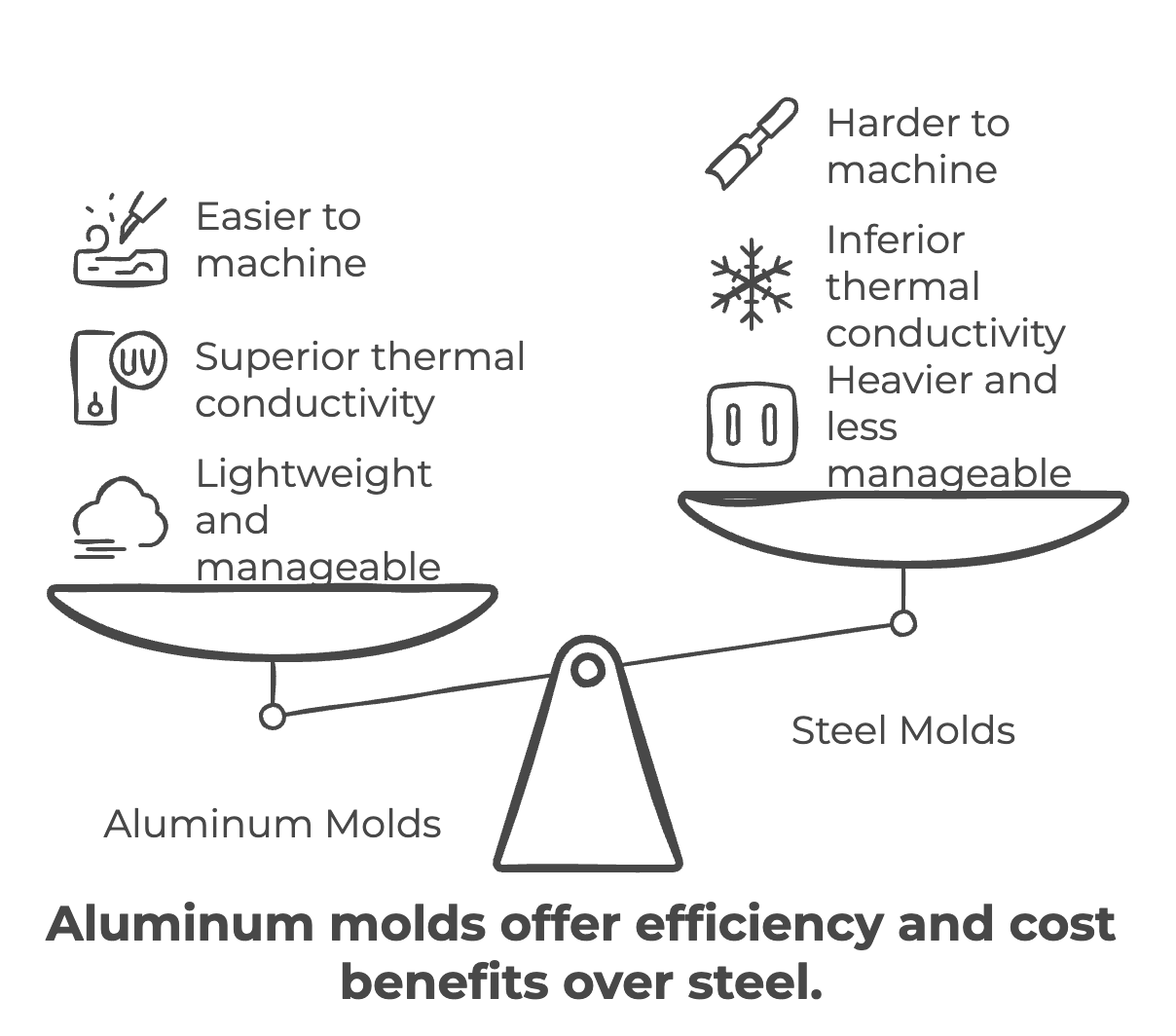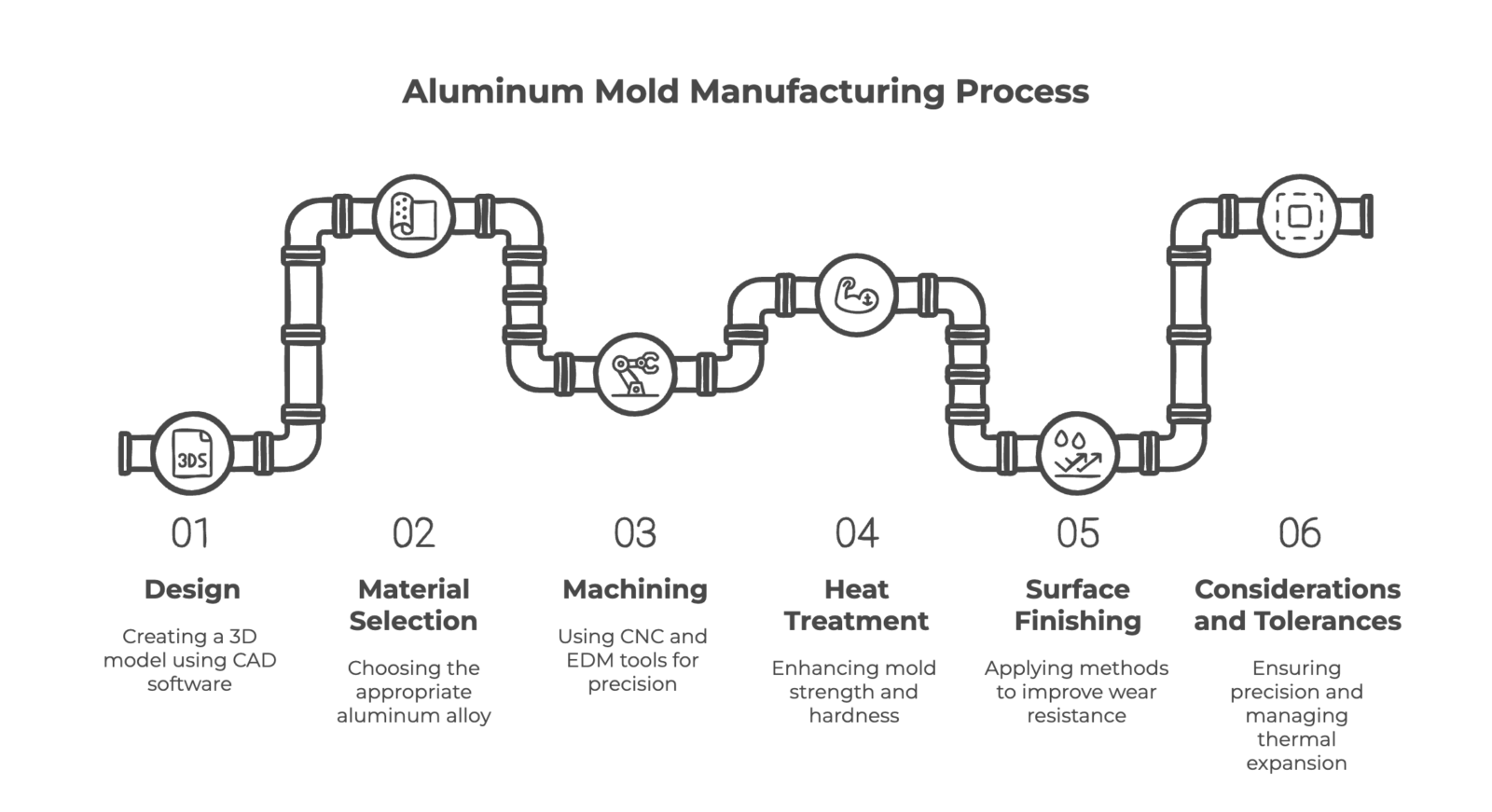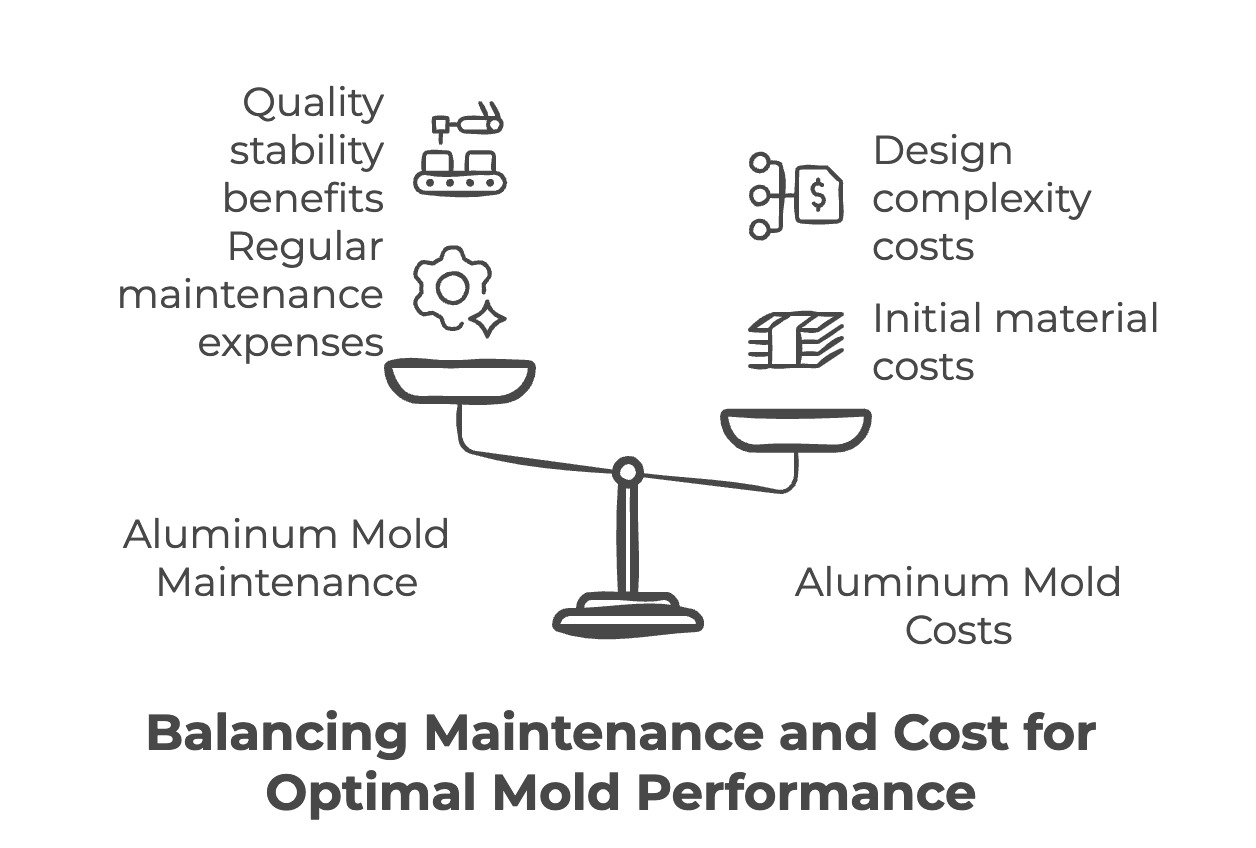◆Table of contents
ToggleIntroduction
Aluminum molds are essential tools for manufacturing various products. Especially for products requiring mass production, they are highly valued for their precision and efficiency. This article provides a comprehensive overview of what aluminum molds are, their types and characteristics, manufacturing processes, selection criteria, and the latest technological trends. This article aims to be a valuable source of information for those considering the introduction of aluminum molds and those who want to learn more about aluminum molds.
In recent years, the manufacturing industry has been strongly demanding product weight reduction, production efficiency improvement, and cost reduction. Aluminum alloys are attracting attention as materials that meet these needs, and the demand for aluminum molds is increasing accordingly. Aluminum molds are lighter and have better thermal conductivity than conventional steel molds, so they can be expected to improve productivity by shortening processing time and reduce costs accordingly. In recent years, technological innovations surrounding aluminum molds, such as 3D printing technology and the development of high-performance aluminum alloys, have been remarkable, and their application range is expanding.
What is an Aluminum Mold?
Definition of Aluminum Mold
An aluminum mold is a mold made from aluminum alloy. It is mainly used for molding plastics and metals, and can mass-produce products of desired shapes by pouring molten material into the mold and cooling and solidifying it.
Characteristics and Advantages of Aluminum Molds
Aluminum molds have the following characteristics and advantages compared to other mold materials (e.g., steel).
- Lightweight: Aluminum is about 1/3 lighter than steel in specific gravity, making it easier to handle and replace molds. Work efficiency can be maintained even with large molds.
- Thermal Conductivity: Aluminum has excellent thermal conductivity, which shortens cooling time and contributes to shortening production cycles and improving productivity. As a result, energy consumption can also be reduced.
- Machinability: Aluminum is softer than steel and easier to cut and electrical discharge machine. This makes it possible to shorten mold manufacturing time and reduce costs. Molds with complex shapes can also be manufactured relatively easily.
- Cost Efficiency: In general, aluminum molds have lower manufacturing costs than steel molds, and are especially suitable for small-volume production and prototype manufacturing. Initial investment can be reduced, which leads to lower development costs.
Types of Aluminum Molds
Aluminum molds come in various types depending on the application and manufacturing method. The main types are as follows.
| Mold Type | Description | Main Applications | Characteristics |
|---|---|---|---|
| Permanent Mold | Reusable mold | Gravity casting, low-pressure casting | |
| Die Casting Mold | High-pressure injection of molten metal | Die casting | High dimensional accuracy and surface roughness |
| Gravity Casting Mold | Pouring molten metal by gravity alone | Gravity casting | Lower cost than die casting mold |
| Prototype Mold | Used for prototypes and small-volume production | Early stages of product development | Product shape and function confirmation |
- Permanent Mold: A reusable mold, mainly used for gravity casting and low-pressure casting.
- Die Casting Mold: Used for die casting, which injects molten metal into the mold at high pressure. Suitable for products requiring high dimensional accuracy and surface roughness.
- Gravity Casting Mold: Used for gravity casting, which pours molten metal into the mold by gravity alone. Characterized by lower manufacturing costs compared to die casting molds.
- Prototype Mold: A mold used for prototypes and small-volume production in the early stages of product development. Used to check product shape and function.
Aluminum Mold Manufacturing Process
The aluminum mold manufacturing process is a complex process that requires advanced technology and precise work. To produce high-quality aluminum molds, proper management and skilled engineer expertise in each process are essential.
Design
Aluminum mold manufacturing begins with designing the mold based on product design data. Using software such as CAD (Computer Aided Design), a 3D model is created, and necessary shapes, dimensions, cooling paths, etc. are designed. At this stage, it is important to consider product shape, function, required strength, manufacturing method, etc. to create the optimal mold design.
Material Selection and Alloy Properties
Once the mold design is complete, the next step is to select the aluminum alloy to be used. Aluminum molds typically use aluminum alloys such as 2024, 6061, and 7075. Each alloy has different properties, so it is necessary to select the optimal material depending on the application.
- 2024: High strength and excellent fatigue resistance, but low corrosion resistance, so surface treatment may be required.
- 6061: A versatile alloy with a good balance of strength, corrosion resistance, and machinability.
- 7075: Boasts very high strength, but machinability is inferior to other alloys.
Machining, Heat Treatment, and Surface Finishing
After material selection, the mold is precisely machined based on design data using machine tools such as CNC machining centers and electrical discharge machines (EDM). After machining, heat treatment is performed as needed to improve mold strength and hardness. As a final step, surface finishing is performed to improve mold wear resistance and release properties. There are various surface finishing methods, including polishing, buffing, and coating.
Considerations and Tolerances
In aluminum mold manufacturing, the following points should be noted:
- Dimensional Tolerances: Aluminum is a softer material than steel, so care must be taken to prevent deformation during machining. Strict tolerance control is required to ensure precise dimensional accuracy.
- Thermal Expansion: Aluminum has a high coefficient of thermal expansion, which can cause the mold to deform due to temperature changes. Design should consider temperature changes in the operating environment.
Advantages and Disadvantages of Aluminum Molds
Aluminum molds have various advantages, but they also have disadvantages. It is important to consider the introduction after understanding both aspects.
| Item | Advantages | Disadvantages |
|---|---|---|
| Cost | Lower cost than steel molds | |
| Delivery Time | Shorter delivery time than steel molds | |
| Weight | Lightweight | |
| Thermal Conductivity | Excellent | |
| Durability | Inferior to steel molds | |
| Suitability for High-Temperature Environments | Low | |
| Wear | More prone to wear than steel molds |
Advantages
- Cost Reduction: Aluminum molds generally have lower manufacturing costs than steel molds. This is due to the relatively low material cost of aluminum alloys and the good machinability of aluminum, which can shorten machining time. Especially in small-volume production and prototype manufacturing, the cost benefits are significant.
- Short Delivery Time: The manufacturing time for aluminum molds is shorter than for steel molds. This is also due to the good machinability of aluminum. This contributes to speeding up product development by enabling short delivery times.
- Lightweight: Aluminum is a lightweight material, so aluminum molds are also lightweight. This makes mold handling, installation, and replacement easier, leading to improved work efficiency.
- Thermal Conductivity: Aluminum has excellent thermal conductivity, which can shorten the molding cycle. Shorter cooling times contribute to improved productivity and reduced energy consumption.
Disadvantages
- Durability: Aluminum molds are less durable than steel molds. They are prone to wear and are not suitable for long-term use or mass production. However, durability can be improved by applying appropriate surface treatments.
- Suitability for High-Temperature Environments: Aluminum molds are not suitable for use in high-temperature environments. High temperatures can cause the mold to deform or lose strength. Therefore, steel molds are suitable for products that need to be molded at high temperatures.
- Wear: Aluminum molds are more prone to wear than steel molds. Especially areas where friction occurs wear quickly, requiring regular maintenance and part replacement.
Applications and Selection Criteria for Aluminum Molds
Aluminum molds are widely used in various industrial fields. Their applications are diverse, and the required properties vary. To select the appropriate aluminum mold, it is necessary to consider product requirements, production volume, budget, usage environment, etc.
Applications of Aluminum Molds
Aluminum molds are used in the following industrial fields:
- Automotive Industry: Due to the increasing need for vehicle weight reduction, aluminum molds are used to manufacture various parts such as engine parts, interior parts, and exterior parts. In particular, the manufacture of aluminum wheels by die casting is one of the representative applications of aluminum molds.
- Aerospace Industry: Aluminum molds also play an important role in the aerospace industry, where lightweight and high-strength parts are required. Aluminum castings are used for aircraft engine parts and airframe structural parts.
- Consumer Goods: Aluminum molds are also used for manufacturing home appliance housings and plastic products. The high thermal conductivity of aluminum molds contributes to shortening molding cycles and improving production efficiency.
- Medical Equipment: Aluminum molds are also used for manufacturing medical equipment that requires high precision and cleanliness.
Selection Criteria for Aluminum Molds
When selecting aluminum molds, it is important to consider the following four criteria:
- Product Requirements: Clearly define the required quality requirements such as product shape, dimensional accuracy, surface roughness, required strength, heat resistance, and corrosion resistance. Die casting molds and lost wax casting molds are suitable for complex shapes and high precision requirements.
- Production Volume: Aluminum molds are suitable for small-volume production because they can reduce initial investment. For mass production, high-durability steel molds may be more suitable.
- Budget: Aluminum molds have lower initial costs than steel molds, but it is necessary to consider long-term running costs because they have lower durability.
- Usage Environment: It is also necessary to consider usage temperature, surrounding environment, and chemical resistance. When used in high-temperature or corrosive environments, proper surface treatment and alloy selection are important.
By comprehensively evaluating these criteria and selecting the optimal aluminum mold, high-quality products can be produced efficiently.
Aluminum Mold Maintenance and Costs
Proper maintenance is essential to maintain the performance of aluminum molds and extend their lifespan. Also, the cost of aluminum molds affects the entire manufacturing process, so it is important to understand cost optimization methods.
Aluminum Mold Maintenance
By performing regular maintenance, it is possible to extend the life of aluminum molds and produce products of stable quality. The main maintenance tasks are as follows.
- Cleaning: After use, carefully remove resin, metal residues, dirt, etc. adhering to the mold surface. Use appropriate cleaning agents and be careful not to damage the mold.
- Lubrication: Regularly apply lubricant to the movable parts of the mold. This reduces wear due to friction and prevents mold malfunction.
- Storage: When not in use, the mold should be stored in a suitable environment to protect it from moisture and dust. Apply rust preventive and store in a dry place to prevent mold deterioration.
- Repair: If the mold is damaged or worn, it should be repaired promptly. Even minor damage can develop into a major problem if left unattended.
Aluminum Mold Costs
The cost of aluminum molds is determined by the following factors.
- Material Costs: Varies depending on the type and amount of aluminum alloy used. High-strength or special alloys tend to be more expensive.
- Machining Costs: Varies depending on mold shape, complexity, and required machining accuracy. Machining costs are higher when advanced machining techniques or special tools are required.
- Maintenance Costs: Varies depending on the frequency of mold maintenance and repair costs.
Aluminum Mold Cost Optimization Methods
To optimize the cost of aluminum molds, the following methods are effective.
- Appropriate Alloy Selection: Select the cheapest alloy that meets the characteristics required for the product.
- Efficient Mold Design: Material costs can be reduced by thinning the wall thickness or removing unnecessary shapes. Also, designing for higher cooling efficiency can shorten the molding cycle and improve productivity.
- Selection of Appropriate Manufacturing Method: Select the optimal manufacturing method (sand casting, die casting, lost wax casting, etc.) according to the type and quantity of product and the required quality.
- Regular Maintenance: Regular maintenance extends mold life and reduces repair costs.
By combining these methods, the cost of aluminum molds can be effectively optimized and product competitiveness can be enhanced.
Summary
This article has provided a comprehensive overview of aluminum molds, covering their definition, types, characteristics, manufacturing processes, advantages and disadvantages, applications, selection criteria, maintenance, and costs.
Aluminum molds are used in various industrial fields due to their lightweight properties, thermal conductivity, good machinability, and cost efficiency. They are especially suitable for small-volume production and prototype manufacturing, and contribute to speeding up product development.
On the other hand, because they have disadvantages such as low durability and suitability for high-temperature environments, it is important to select the appropriate mold material according to the application and conditions.
By performing regular maintenance, the life of aluminum molds can be extended and performance can be maintained. Also, costs can be reduced by optimizing material selection, mold design, manufacturing methods, etc.
Aluminum mold technology continues to evolve, including 3D printing and new alloy development. It is important to pay attention to future trends and maximize the benefits of aluminum molds.



